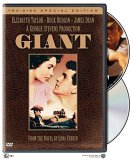Spanning a good thirty years, Giant tells the tale of the Benedicts, a Texas family on an immense cattle range. The patriarch is Rock Hudson, whom we first meet as a young man visiting Maryland to buy a horse. There he meets Elizabeth Taylor and falls in love. His new bride initially finds Texas difficult to adjust to, and Texas has difficulty adjusting to her, as she does not hold with the local attitudes towards women and, most especially, Mexicans. The third major player is James Dean, a rather sullen ranch hand who winds up changing everybody’s lives when he strikes oil on his small parcel of land.
This is a big film, with big scope, big stars, big performances, big virtues, and big flaws. It is at its best as it works out the family dynamics, with Hudson and Taylor bouncing off each other.James Dean, though he has comparatively little screen time, turns in a remarkable performance,and as the characters move into middle-age, his is the most convincing transformation. The film is at its weakest in its ham-fisted handling of the racial issues. These scenes play out in deeply predictable fashion, and the symbolism of the final scene is so obvious, yet takes itself so seriously, that the film ends on a note of high camp. But even these problems make up part of the charm, and its 201 minutes go by surprisingly quickly. They don’t make ‘em like this anymore,and nor should they, but thank God they did in 1956.
Audio
The mix is 2.0 surround, and for a 1956 feature, I really don’t think one could hope for much better. The sound is very crisp, and the only moment of distortion is during the thunderous blast of Dean’s first oil gusher, and even then, this is also one of the most impressive surround moments. For the most part, the surround aspects are quite low key. The rear speakers are active,and there are some nice environmental moments, but for the most part, one isn’t too aware of surround activity. The upside of this is that there are no misplaced surround effects, such as dialogue wrapping around when it shouldn’t, and the big blasts that show up from time to time get the surround treatment most satisfactorily.
Video
The movie was shot in Eastman color, the cheaper, less vibrant alternative to Technicolor,and all the lab processing in the world couldn’t quite generate the lushness of the latter. Still, the colours here are pretty damn good, suggesting the DVD transfer is very faithful to the original print. This print is in perfect condition: not a speck of dust, and the only visible grain occurs during some back projection. The only notable flaw is the haloing that occurs whenever the contrasts get strong enough, especially around black figures outlined against the Texas prairie. At such moments, the edge halo is sometimes quite distracting in its prominence. Otherwise, this is a fine looking release. The layer transition is a bit awkward, but on the other hand, the division between sides 1 and 2 of the disc is perfectly timed.
Special Features
This is a 2-disc set that certainly warrants both discs. Disc 1 features a commentary by George Stevens Jr., film critic Stephen Farber, and Screenwriter Ivan Moffat. Thus, we have input from people who worked on the film, as well as historical perspective. All three gentleman are interesting, articulate speakers, and their discussion contains a wealth of information. The other extra on Disc 1 is “George Stevens: Filmmakers Who Knew Him,” which is a collection of interviews (some vintage) with such luminaries as Warren Beatty, Frank Capra and Robert Wise, among others.
Disc 2 has two big documentaries. “Memories of Giant” concentrates on cast and crew reminiscences, some filmed recently, others (such as the interviews with Rock Hudson) clearly not, yet all very well integrated. “Return to Giant” sets the film in the context of the Texas shoot,and features lots of vintage behind-the-scenes footage. There are three newsreels (two of them about the film’s premiere, one for New York and the other for Hollywood). More behind-the-scenes extras are the still gallery and the document gallery (all the memos you could ever hope to read). There are two promotional featurettes (one is “On Location in Marfa, Texas” and the other is “A Visit with Dimitri Tiomkin”) and these, by virtue of their age, are fascinating historical documents in their own right, and then there are four trailers. The features are rounded out by “AG iant Undertaking” (brief notes and quotations covering a variety of subjects), a George Stevens filmography, and awards list, and a cast list. The menu has a scored main, but it is otherwise very basic.
Closing Thoughts
A very complete package. It would be hard to imagine how much more could have been added as far as extras are concerned, and the amount of vintage behind-the-scenes stuff is very impressive. The film looks and sounds great, and is still a hell of a lot of fun to watch. This is a soap opera, but a grand one. Highly recommended.





